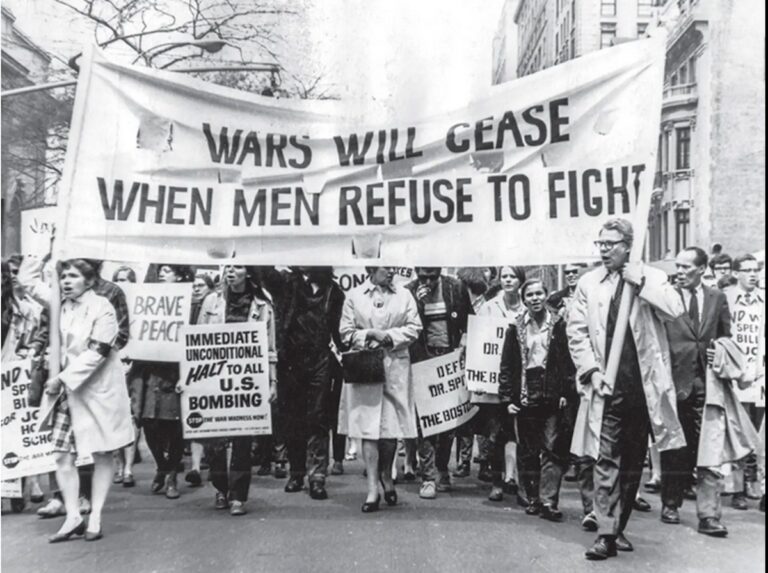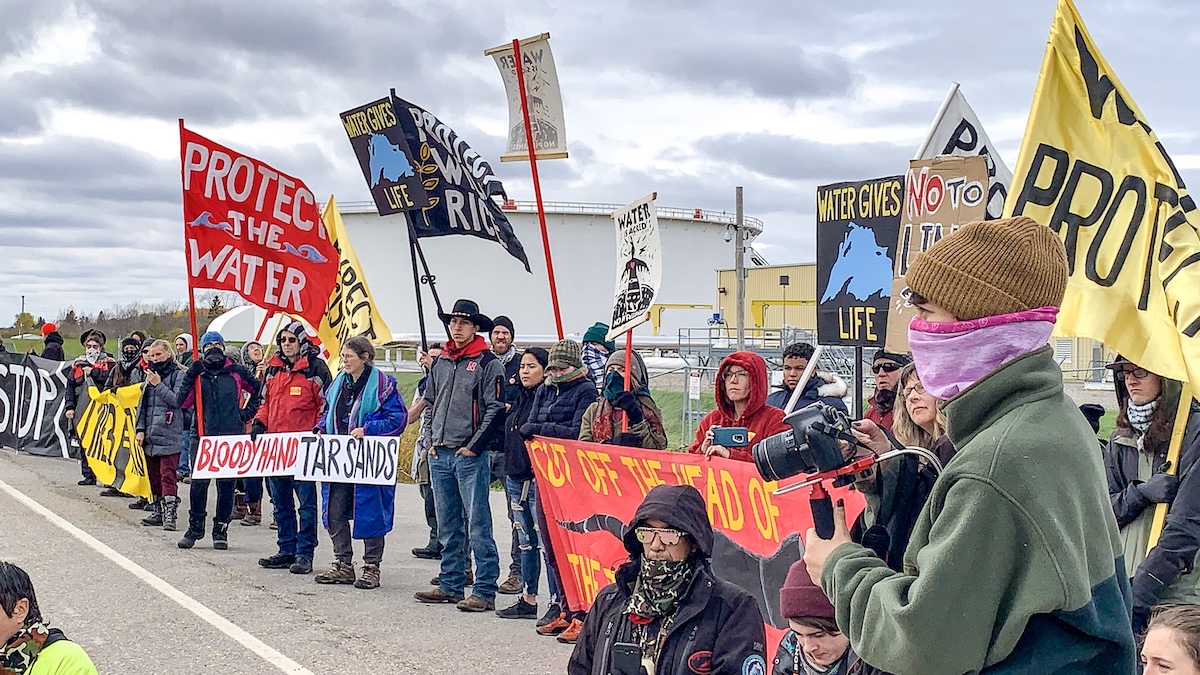The War Resisters League’s storied hundred-year history is celebrated in a new book and traveling display.
By Arnie Alpert
Perhaps your first exposure to the War Resisters League, or WRL, was at a demonstration where someone handed you a small card, with a piece of string looped through a punched hole, and the slogan, “Practice Nonviolence.”
Perhaps your first exposure was a Tax Day pie chart showing that appalling amount of national resources devoted each year to the war machine.
Perhaps your first exposure was a pamphlet on refusing military recruitment, an issue of WIN Magazine, a friend’s datebook or a map of nuclear facilities.
Perhaps you don’t remember because WRL has been around for so long, 100 years, in fact.
I don’t exactly remember my introduction, but I do remember calling up WRL’s Joanne Sheehan to lead a nonviolence training workshop at my college prior to the 1977 Seabrook nuclear power plant occupation. At the nuclear plant construction site on the New Hampshire Seacoast, I remember an affinity group that called itself “339,” named for the address of WRL office on Lafayette Street in lower Manhattan. The group seemed to be on the militant side of the thoroughly peaceful demonstration where 1,415 people were arrested. Soon afterward, as I delved more deeply into nonviolence theory and practice, I started reading WIN Magazine, published by WRL, and signed a card saying I believed that war is a crime against humanity.
The following year I spent two weeks at a WRL Training Program for Organizers. What stays with me is not so much the workshops on skills — like how to silkscreen T-shirts and write press releases, or the deep discussions about nonviolence — but the meetings we had with an older generation of activists involved with issues such as apartheid, Middle East peace and nuclear disarmament. The exposure helped me internalize the idea that despite my parents’ well-intentioned wishes, I might not be just going through a phase.
Perhaps you’ve never encountered WRL at all, in which case this is as good a time as any to get acquainted.
WRL is an essential organization in the history of America pacifism. Like the Fellowship of Reconciliation, the Women’s International League for Peace and Freedom, and the American Friends Service Committee, WRL grew out of revulsion to violence during World War I. By defining itself in bluntly secular terms, WRL was in some way better positioned to reach a broad public than its more narrowly constituted counterparts. Initially focused on support for non-religious conscientious objectors, it later became one of the key groups applying Gandhian nonviolence to a wide range of American issues.
Now observing its centennial, the organization’s storied history has been made more accessible by a traveling display and an attractively designed 84-page booklet, “100 Years of Resistance to War and the Causes of War.”
The display — which you can bring to your community — consists of eight free-standing panels, each 83 inches high and 34 inches wide, on topics including resistance to nuclear weapons and power, demilitarization and connecting with international movements. It is accompanied by a timeline banner, 12 feet long and 4 feet high.
Adapted from the display, the booklet is longer on graphics than words, coming across more like a scrapbook to be leafed through than a historical treatise to be studied. Like the display, it comes with QR codes to scan and open up resources on organizing skills, nonviolence training, historical movements, WRL’s printed resources, and issues like countering military recruitment and police violence.
Many of the dozens of short narratives and most of the captioned photos recount protests, going back to the league’s earliest years. In addition, there is also wisdom to be gleaned from episodes in WRL’s history. For example, the section on “Militant Pacifism and Revolutionary Nonviolence” recounts the challenges brought on by government spying in the 1960s and ‘70s. “WRL found that its best defense against government harassment was to minimize secrecy and continue to organize openly,” it says. Still sound advice.
A striking feature of WRL’s telling of its own story is that it’s not narrowly about WRL. Instead, it names dozens of campaigns, protests and projects in which the league was involved, but did not necessarily claim to be in the lead. For example, WRL staff and members played key roles in the Committee on Nonviolent Action, which applied Gandhian methods to protest nuclear weapons in the 1950s and 60s. WRL members, including Igal Roodenko, Bayard Rustin and Jim Peck, participated in the first Freedom Ride, the 1947 Journey of Reconciliation which was formally sponsored by the Congress of Racial Equality. WRL helped launch Liberation, a radical pacifist journal that published articles by writers such as Staughton Lynd, David Dellinger, Barbara Deming, Martin Luther King Jr., early counter-cultural images by iconic artist Vera Williams and others. The willingness to collaborate and to often remain in the background calls to mind historian Aldon Morris’s term, “movement halfway house.”
In his 1984 book “The Origins of the Civil Rights Movement,” Morris defined this term — in reference to WRL, AFSC, FOR and Highlander Folk School — as an organization outside the dominant culture and lacking a mass base, but with the capacity to provide “a battery of social change resources, such as skilled activists, tactical knowledge, media contacts, workshops, knowledge of past movements, and a vision of a future society.” During the U.S. war in Vietnam, it was that capacity that enabled WRL, always a relatively small organization, to continue to play a major role as the antiwar movement took off well beyond the ranks of “militant pacifists.”
This new book reproduces WRL’s entire 100th anniversary traveling exhibit.
While it has consistently connected issues, including feminism, gay liberation, racism and the prison system, WRL has always kept its focus on militarism and war through the generations. “This pattern of generational shifts is continuous,” the centennial booklet states. “WRL staff and board members have participated in required trainings and workshops on feminism, sexism, male dominance, white privilege and racism over the years. Primarily an antiwar organization with multi-issue concerns, WRL has allied with hundreds of coalitions for social justice under the leadership of those with expertise on any give issue.”
Apparently, too, the War Resisters League has a sense of humor. While other groups might print positive blurbs — perhaps an excerpt from a review — on the back cover of a commemorative booklet, this one bears several quotes that were not meant to be complimentary. “[T]he WRL took a leading role in establishing the pattern of ‘mass civil disobedience’ and ‘nonviolent resistance’ — including the physical and psychological conditioning of militant pacifist ‘shock troops,’” charged Larry McDonald, a Georgia Congressman who was active in the John Birch Society and had a portrait of Francisco Franco on his office wall. “The War Resisters League appears to be a genuine pacifist organization and doesn’t preach the use of violence against any group including the police. In fact, their strongest tactic employed at demonstrations is civil disobedience,” reported the NYPD in a 1971 surveillance report.
WRL and its associates must have gotten used to criticism. When the famed antiwar activist and Jesuit priest Daniel Berrigan faced pushback for condemning Israel as well as the Arab states in the 1973 Yom Kippur War, WRL gave him its annual peace prize the following year. Presenting the award, the poet Allen Ginsburg said, “To Daniel Berrigan, for his irritating vocation as a prophet in our times, angering us in our complacency, embracing us in our humanity. Leaping beyond his own limits, he has led us beyond ours.”
With 100 years of prophetic troublemaking behind it, let’s hope WRL continues to arouse people from complacency, foment the practice of nonviolence and help people leap beyond their limits in the effort to end war. It’s a goal as important as ever.


